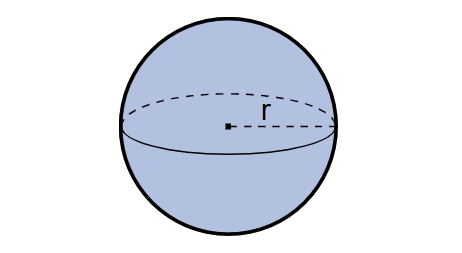1. What is an Area of a Sphere Calculator?
Definition: This calculator computes the diameter, volume, surface-to-volume ratio, and surface area of a sphere given its radius \( r \). A sphere is a three-dimensional object where every point on its surface is equidistant from its center. The calculator supports length units (mm, cm, m, in, ft, yd) and area/volume units (mm², cm², m², in², ft², yd² for area; mm³, cm³, m³, in³, ft³, yd³ for volume), defaulting to m for inputs and lengths, and m²/m³ for area/volume. The surface-to-volume ratio supports units (1/cm, 1/m, 1/in, 1/ft, 1/yd), defaulting to 1/m.
Purpose: It aids in geometry education and practical applications by calculating key properties of spheres, useful in fields like physics, engineering, and design for objects like balls, planets, or bubbles.
2. How Does the Calculator Work?
The calculator uses the following formulas for a sphere with radius \( r \):
- Diameter: \( d = 2r \)
- Volume: \( V = \frac{4}{3} \pi r^3 \)
- Surface Area: \( A = 4 \pi r^2 \)
- Surface-to-Volume Ratio: \( A/V = \frac{3}{r} \)
Steps:
- Input the radius \( r \), with the unit defaulting to m.
- Select the desired output units for diameter, volume, surface-to-volume ratio, and surface area (defaulting to m, m³, 1/m, and m²).
- Validate input: ensure \( r > 0 \).
- Convert the radius to meters for calculation.
- Compute the diameter, volume, surface area, and surface-to-volume ratio using the formulas above.
- Convert the results to the selected units.
- Display results with lengths, volume, area, and ratio to 4 decimal places.
3. Importance of Sphere Area and Volume Calculations
Sphere calculations are essential for:
- Physics: Modeling spherical objects like atoms or capacitors, where surface area affects heat transfer or capacitance.
- Astronomy: Estimating volumes of celestial bodies like planets, approximated as spheres (e.g., Earth’s radius is about 6370 km).
- Engineering: Designing spherical containers or pressure vessels, where surface-to-volume ratio impacts efficiency.
4. Using the Calculator
Examples:
- Example 1: Radius \( r = 1 \) m, Outputs in m, m³, 1/m, m²
Diameter: \( d = 2 \cdot 1 = 2.0000 \) m
Volume: \( V = \frac{4}{3} \pi \cdot 1^3 \approx 4.1888 \) m³
Surface-to-Volume Ratio: \( A/V = \frac{3}{1} = 3.0000 \) 1/m
Surface Area: \( A = 4 \pi \cdot 1^2 \approx 12.5664 \) m².
- Example 2: Radius \( r = 50 \) cm, Diameter in mm, Volume in cm³, Ratio in 1/cm, Area in cm²
Convert to meters: \( r = 0.5 \) m
Diameter: \( d = 2 \cdot 0.5 = 1.0000 \) m = 1000.0000 mm
Volume: \( V = \frac{4}{3} \pi \cdot 0.5^3 \approx 0.5236 \) m³ = 523598.7756 cm³
Surface-to-Volume Ratio: \( A/V = \frac{3}{0.5} = 6.0000 \) 1/m = \( 6.0000 \cdot 100 = 600.0000 \) 1/cm
Surface Area: \( A = 4 \pi \cdot 0.5^2 \approx 3.1416 \) m² = 31415.9265 cm².
- Example 3: Radius \( r = 2 \) ft, Outputs in ft, ft³, 1/ft, ft²
Convert to meters: \( r = 2 \cdot 0.3048 = 0.6096 \) m
Diameter: \( d = 2 \cdot 0.6096 \approx 1.2192 \) m = 4.0000 ft
Volume: \( V = \frac{4}{3} \pi \cdot 0.6096^3 \approx 0.9499 \) m³ = 33.5480 ft³
Surface-to-Volume Ratio: \( A/V = \frac{3}{0.6096} \approx 4.9213 \) 1/m = \( 4.9213 \cdot (1/0.3048) \approx 1.5000 \) 1/ft
Surface Area: \( A = 4 \pi \cdot 0.6096^2 \approx 4.6665 \) m² = 50.2445 ft².
5. Frequently Asked Questions (FAQ)
Q: What is a sphere?
A: A sphere is a three-dimensional object where every point on its surface is equidistant from its center, such as a ball or a planet.
Q: Why do inputs and outputs default to m, m³, and m²?
A: Meters (m), cubic meters (m³), and square meters (m²) are the default units to provide a standard metric base, but you can convert to other units as needed.
Q: Why does the surface-to-volume ratio have its own unit dropdown?
A: The surface-to-volume ratio (\( A/V = 3/r \)) has units of inverse length (e.g., 1/m). The dropdown allows you to choose the inverse length unit (e.g., 1/cm, 1/ft) independently of other outputs.
 Home
Home
 Back
Back
